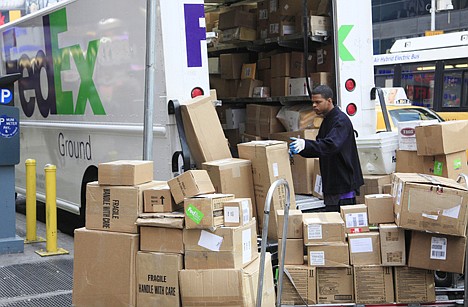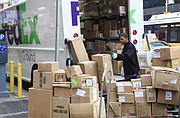Consumers spend and earn more
Jeannine Aversa | Hagadone News Network | UPDATED 15 years, 1 month AGO
WASHINGTON - Americans earned more and spent more last month, and the number of people applying for unemployment benefits dropped last week to the lowest level in more than two years. At the same time, demand for long-lasting manufactured goods and new homes fell off.
All told, the latest government data released the day before Thanksgiving suggest an improving picture of the economy. Income and spending are rising, and layoffs are slowing. This comes amid a decline in manufacturing activity, which had been a source of strength for months after the recession ended, and a struggling housing market.
Analysts question whether incomes can continue to grow at a consistent pace and keep consumers spending enough to invigorate the economy.
"The flurry of U.S. data this morning suggests that households have started to pickup the baton of growth from businesses," said Paul Dales, U.S. economist at Capital Economics. "Whether or not households will be able to shoulder the burden of growth on their own is another matter."
Investors appeared to be pleased by the data. The Dow Jones industrial average climbed more than 137 points in the early morning trading.
Consumers boosted their spending 0.4 percent in October, the Commerce Department said Wednesday. That was up from a 0.3 percent increase in September.
People showed a slightly bigger appetite to spend because their incomes rose 0.5 percent, reflecting a slowly healing jobs market that gave a boost to wages and salaries. Incomes didn't grow at all in September. The increases in both income and spending last month were the most since August.
And inflation is running lower at a record low. Prices for goods excluding food and energy rose just 0.9 percent in the 12 months ending in October, the Commerce report noted. That was down from a 1.2 percent annual gain posted in September. Inflation is running at a pace below the Fed's comfort zone of between 1.5 percent and 2 percent.
"We have a good signal," John Silvia, chief economist at Wells Fargo, said of the jobless claims and consumer spending reports.
The pace of layoffs slowed to the lowest level since July 2008. Initial jobless claims dropped by 34,000 to a seasonally adjusted 407,000 in the week ending Nov. 20, the Labor Department said. The report raised hopes that more gains in hiring will be seen.
Still, another report showed that orders to U.S. factories for costly manufactured goods plunged in October by the largest amount in 21 months.
Durable-goods orders dropped 3.3 percent last month, the biggest setback since January 2009, when the country was still mired in a recession.
Of special concern was a 4.5 percent drop in orders for nondefense capital goods, excluding aircraft. This category is viewed as a good proxy for business investment plans. It was the biggest drop since a 5.3 percent fall in July.
Meanwhile, sales of new homes fell in October to near a record low and home prices dropped to the lowest point in seven years.
Sales of new single-family homes declined 8.1 percent to a seasonally adjusted annual rate of 283,000 units in October, Commerce said in another report. That was just 2.9 percent above the all-time low of 275,000 units hit in August for government records that go back to 1963.
The median price of a home sold in October dipped to $194,900, the lowest level since October 2003.
Even with the pickup in spending, consumers are still shying away from the type of buying needed to dramatically lower the 9.6 unemployment rate.
Normally after a recession, consumers spend more freely. But more than one year after the recession ended, Americans are more focused on getting their personal finances in order. They are paring down debt, watching their spending and building savings.
Americans saved 5.7 percent of their disposable income in October. That was up from 5.6 percent in September and was the most since August. Before the recession, they were saving just over 1 percent.
Federal Reserve Chairman Ben Bernanke and other economists worry that high unemployment, hard-to-get-credit, weak home values and lackluster wage growth are forces that will restrain the growth in consumer spending.
To counter that and try to invigorate the economy, the Fed recently launched a $600 billion program to buy government bonds. By doing so, the Fed hopes to boost stock prices and make loans cheaper, positive developments that could make people want to spend more.
Even faced with all the negative forces, Americans are still buying. That's important because their spending accounts for roughly 70 percent of all economic output.
With consumers holding up, fears the economy could slip back into a recession have receded.
In the July-September quarter, consumer spending grew at a 2.8 percent pace, the most in nearly four years.
Leading economists in an AP Economy Survey predict consumer spending will grow at a 2.4 percent pace in the October-December quarter. Consumer spending would need to grow by at least twice that pace to translate into the type of robust economic growth to make a big dent in the nation's unemployment rate.
The nation's unemployment rate has been stuck at 9.6 percent unemployment rate for the past three months. New projections from Federal Reserve suggest that won't change much for a few years.
AP Economics Writers Christopher Rugaber and Martin Crutsinger contributed to this report.
ARTICLES BY JEANNINE AVERSA

Fed survey: U.S. economy ends 2010 on strong note
Rise in business expenses currently not being passed on to customers
WASHINGTON - The U.S. economy ended last year on an encouraging note, with all parts of the country showing improvements. Factories produced more, shoppers spent more and companies hired more - pointing to a stronger economy in 2011.

Businesses hiring at fastest pace since 2006
Unemployment jump to 9 percent seems to be quirk
WASHINGTON - American companies are on a hiring spree.
More spending helps economy gain steam
Will consumers spend enough this year for growth?
WASHINGTON - The economic recovery is now consistently picking up speed, and American consumers are the ones pushing the gas pedal. They increased their spending late last year at the fastest pace since 2006.



